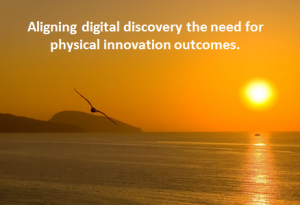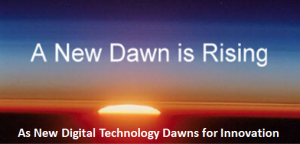 For a big majority of us, open innovation is now well established, it is part of our innovation furniture. The quest for many, today, is the search for richer engagements, possibilities and exchanges. We need to move beyond the existing boundaries and go deeper into the collaborative space.
For a big majority of us, open innovation is now well established, it is part of our innovation furniture. The quest for many, today, is the search for richer engagements, possibilities and exchanges. We need to move beyond the existing boundaries and go deeper into the collaborative space.
I regard collaboration as the active ingredient, the yeast that allows our ‘daily innovation bread’ to rise. Getting all the parties ‘gathered around’ puts increased vitality, energy and commitment into working together over a project or idea.
As we learn to reach out and collaborate, exchanging perspectives and our different thoughts, it is in these interactions, in the many exchanges on-line and off-line that we move towards a real sense of achievement.
Allowing outside ideas through our doors
Open innovation has literally thrown open the doors, many of our research and development activities are increasingly relying on the input from outside. Open innovation is changing our behaviours.
Tackling the internal Jobs-to-be-done for improving Innovation

So Welcome to the Age of Digital Innovation
 Digital technology is about to become the precursor for all the changes we have put off for years within our organizations.
Digital technology is about to become the precursor for all the changes we have put off for years within our organizations.
We need to radically improve our abilities to engage, relate and discover new innovation opportunities at a completely different level of faster performance.
There are many issues both strategic and tactical to work through, to extract the rich potential from any digital transformation for new innovation growth outcomes
The final part of a seven-part series – new dawn or your worst nightmare?’
The Need to Automate the Innovation Process
 There has always been a consistent call to automate the innovation process.
There has always been a consistent call to automate the innovation process.
Now it might turn into a stampede, based on real ‘digital’ need.
We have made solid progress in the use of out-of-the box software for capturing ideas at the ‘fuzzy front end.’
We have developed pipelines and use product life cycle software systems to manage this through to commercialisation.
Yet today we still have a fragmented, often broken innovation process, very reliant on the manual processes, where the human intervention dominates.
Can this be changed? Technology must form a greater core of the innovation process.
The need to respond quickly to new business objectives
 The business objectives will change as we invest heavily in digital technologies, as we increasingly recognize and embrace this changing world where digital knowledge and insights begin to challenge and change our existing frameworks of innovation thinking.
The business objectives will change as we invest heavily in digital technologies, as we increasingly recognize and embrace this changing world where digital knowledge and insights begin to challenge and change our existing frameworks of innovation thinking.
Part five of a seven-part series
The outcomes of the investment are expected to provide clear returns and these might include but are not limited to:
1) different customization of services 2) quicker response to market trends in new offerings 3) identifying real-time cost optimizations, 4) concentrating on faster, more accurate decision-making to give new competitive edges 5) better and more holistic R&D 6) automating even further the supply chain management, 7) alter your approach channels to market, 8) move your business into new adjacencies or even white spaces and finally 9) design new business models and value propositions.
There will be lots of new moving parts to grapple with to be future innovation agile.
IT is Struggling to be the Digital Technology Master
 There is so much occurring in new applications and alternative solutions, it is a very tough position for most dealing in technology to truly master all of these breaking options they might have to consider.
There is so much occurring in new applications and alternative solutions, it is a very tough position for most dealing in technology to truly master all of these breaking options they might have to consider.
It must be a little overwhelming when many responsible for IT have for years not had any strategic involvement and not been given clear line-of-business oversight.
Business management equally has over the years built up an ‘arm’s distance’ to IT and found ways to overcome barriers they felt were seemingly put in their way when it came to ‘bringing in’ the technology they deemed as essential.
Something needs to change going forward. Both the business manager and the IT need to find ways to exchange, collaborate and share. It is in their ‘vested’ interest but more importantly for the future health of the business itself.
Aligning digital discovery with physical innovation outcomes.
 We really do seem to be in a really evolutionary period, with the explosion of change taking place in the post-digital world of cloud, big data, social and interconnected devices.
We really do seem to be in a really evolutionary period, with the explosion of change taking place in the post-digital world of cloud, big data, social and interconnected devices.
The discovery of insights from all this embedded intelligence, social activity and data analytics is leading us to realize a potentially significant wave of new innovation opportunities from this digital knowledge.
The question is “are we internally ready for this?” Are our innovation systems and structures able to adapt to a need for exploiting ‘breaking’ opportunities where speed and agility become a critical deciding factor to capitalize on breaking commercial advantage by tapping into all these fresh insights?
Is the balance in innovation activity about to change?
 Is the digital technology we see emerging today going to be able to provide the positive tension between rational and randomness that takes place in our innovation activities today?
Is the digital technology we see emerging today going to be able to provide the positive tension between rational and randomness that takes place in our innovation activities today?
Will digital begin to dominate our innovative thinking, will we lose this randomness, this spark of human creativity or will it be allowing this to connect multiple strands in new, more exciting ways? How are we going to adjust to the changing way technology will impose itself on our innovation activities and needs?
How will all this Mobile Connectivity, Cloud Computing, Social Media, Crowdsourcing, Internet of Things, Industrial Internet, Big Data, Analytics, 3D Printing and Scanning be presented and managed as a part of successful business scenarios and intertwined with changes in social behaviour?
Are our existing innovation systems ready for this potentially set of sweeping changes in knowledge inflows and translation, so they can be successfully commercialized into new innovation?
Part two within the series of seven
As new digital technology dawns for innovation
 Digital Technology is significantly challenging for organizations to re-think and re-equip due to the emergence of big data, smart mobile connectivity, social media, cloud, analytics and the growing commercialization.
Digital Technology is significantly challenging for organizations to re-think and re-equip due to the emergence of big data, smart mobile connectivity, social media, cloud, analytics and the growing commercialization.
These are all driving external technology change, all clearly pointing towards a significant disruption of the existing ways we conduct business internally. So we need to ask “how are we going to take advantage of the potential business transformation?”
The issue is how to capitalize and create the value from all this change for innovation and performance enhancement?
***This is the first of a seven-part exploratory ‘open thinking’ about digital technology and its potential impact on innovation as we know it today. These will be published daily over the next week. The intent at this stage is more about raising our thinking on what might need changing or at least re-orientation within our innovation management approaches.***
Questioning internally those many product failures
